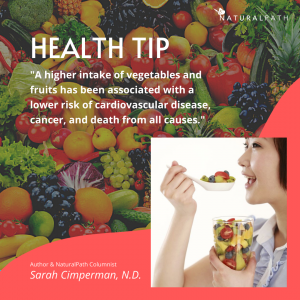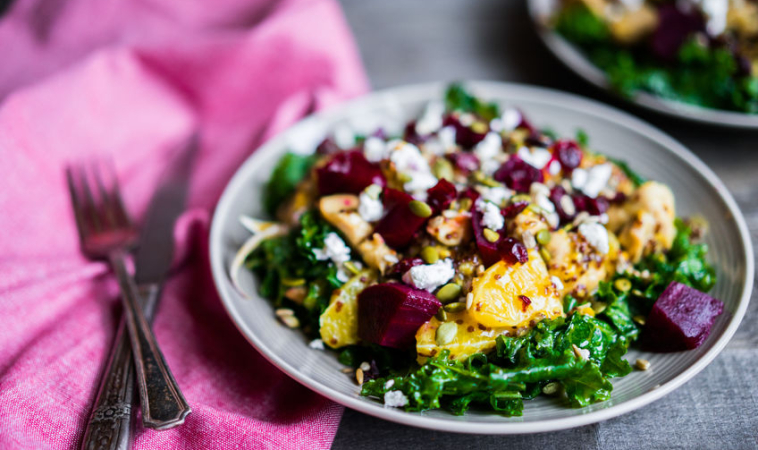As seasons change and the weather lightens up, so does my cooking. Slow-cooked roasted and braised dishes make way for steamed, sautéed, and raw ones while hearty soups are replaced by colorful salads. Salads can be starters, side dishes, main courses, or even a separate course at the end of meals to cleanse the palate before cheese or dessert. Main course salads are one of my favorite summer staples for quick and healthy lunches because they are versatile and easy to make.
Salads are compositions of ready-to-eat components seasoned with a dressing. Vegetables are some of the most popular components, but salads can also be made up of fruit, nuts, grains, beans, cheese, meat, or seafood. Salad dressings are often made with an acid—like vinegar or citrus juice—and an oil like olive oil, avocado oil, or sesame oil. In some cases the oil may be replaced by another kind of fat like mayonnaise, buttermilk, sour cream, or heavy cream in the case of slaw salads and creamy dressings like ranch and blue cheese. Salad dressings are usually seasoned with salt and pepper and may also contain aromatic ingredients like mustard, garlic, shallot, scallion, ginger, lemongrass, and fresh or dried herbs.
Healthy main course salads have five essential ingredients: non-starchy vegetables, protein, healthy fat, a fermented food, and a home-made dressing. About fifty percent of the salad should non-starchy vegetables and about twenty-five percent should be a protein-rich food. The remaining twenty-five percent can be anything else that is ready to eat like nuts, seeds, cheese, cooked beans or grains, or more vegetables. This flexibility will accommodate any dietary restriction so salads can be gluten-free, grain-free, dairy-free, Paleo, vegan, vegetarian, or pescatarian. Here’s a closer look at these five essential ingredients.
50% Non-Starchy Vegetables

Research studies show that a higher intake of vegetables and fruits has been associated with a lower risk of cardiovascular disease, cancer, and death from all causes.1 Vegetables are good sources of vitamins, minerals, antioxidants, and fiber. Fiber normalizes bowel movements, lowers cholesterol, improves blood sugar metabolism, and reduces the risk of diabetes, heart disease, and cancer. Fiber also supports a healthy microbiome, the protective microbes that live in our digestive tract.
Raw or cooked vegetables should make up at least half of any main course salad. Starchy vegetables like potatoes and winter squashes are excluded but non-starchy options abound: lettuce, spinach, watercress, kale, cucumbers, tomatoes, peppers, radishes, zucchini and summer squash, asparagus, avocado, broccoli, Brussels sprouts, celery, cabbage, cauliflower, chard, endive, collard greens, eggplant, mustard greens.
25% Protein
Protein is important for cell growth and tissue repair. Proteins act enzymes, hormones, and chemical messengers that facilitate communication between cells, tissues, and organs. Proteins are necessary to maintain fluid balance, transport substances around the body, make antibodies that fight infection, and regulate the pH of body fluids like blood. Our bodies can’t store protein so we need to get it regularly from our diet.
Protein-rich foods should make up about a quarter of main course salads. They can come from animal sources like hard-boiled eggs, cheese, meat, or fish, or from plant sources like nuts, seeds, beans, tofu, or tempeh. Avoid fake soy-based meats and cheeses, and processed meats like deli slices, bologna, and salami.
Healthy Fat
Fats help us absorb fat-soluble vitamins and they provide our bodies with energy. They protect and insulate our internal organs and regulate our digestion. Fats help build cells, tissues, organs, nerves, hormones, and chemical messengers that allow our cells to communicate with the rest of the body and with the brain. The brain is sixty percent fat.
Healthy forms of fat to put in your salad include avocado, olives, raw nuts and seeds, fish and seafood. Eggs from pasture-raised chickens contain healthy fat and they can be boiled and added as a component or used to thicken a dressing. Whole milk dairy products from pasture-raised cows and contain healthy fat including cheese, buttermilk, sour cream, and heavy cream. Healthy fats also include cold-pressed liquid oils (olive, avocado, sesame) and tahini used in salad dressings.
Fermented Food
Fermented foods contain friendly bacteria that protect us from disease-causing microbes. They break down environmental toxins, help digest our food, and manufacture essential nutrients like vitamins and short chain fatty acids. They also modulate the immune system, help regulate inflammation, influence the production of neurotransmitters like serotonin, and play an important role in appetite, satiety, fat accumulation, and energy usage.
Fermented foods include vinegar, pickled vegetables, sauerkraut, kimchi, tamari, tempeh, miso, and aged cheeses. To get the biggest benefit look for labels listing “live cultures” and for products that have not been pasteurized after fermentation. Or make your own pickled vegetables with live cultures. It’s surprisingly easy.
Home-Made Salad Dressing
Store-bought salad dressings are convenient but most are full of unhealthy oils, sugar, flavor enhancers, thickeners, and artificial preservatives. If you want to just open up a bottle to dress your salad, use good-quality oil and vinegar. If you’re willing to invest a couple of minutes, make your own salad dressing. Most recipes are easy to prepare and can be kept in the fridge a week or more, like the one below.
2-Minute Salad Dressing
Ingredients:
1 cup cold-pressed extra virgin olive oil
1/3 cup red wine vinegar or apple cider vinegar
1 or more cloves fresh garlic, grated or minced
Pinch sea salt
Ground peppercorn to taste
Additional ingredients (optional):
1 tablespoon mustard
3 tablespoons minced shallot, scallion, or red onion
1 tbsp minced fresh herbs (basil, oregano, cilantro, parsley, dill)
Directions:
1. Add all ingredients to a clean glass jar and close the lid tightly.
2. Shake until everything is combined.
3. Store in the fridge.
References:
1 Aune D, Giovannucci E, Boffetta P, Fadnes LT, Keum N, Norat T, et al. Fruit and vegetable intake and the risk of cardiovascular disease, total cancer and all-cause mortality-a systematic review and dose-response meta-analysis of prospective studies. International Journal of Epidemiology. 2017;46(3):1029-1056. https://pubmed.ncbi.nlm.nih.gov/28338764/

Sarah Cimperman, ND is the author of the new book, The Prediabetes Detox: A Whole-Body Program to Balance Your Blood Sugar, Increase Energy, and Reduce Sugar Cravings. She graduated from NCNM in 2002 and has a private practice in New York City. Her expertise has been featured on Fox News and Huffington Post and in Natural Health magazine, Whole Living magazine, and the Well Being Journal, among other publications. Dr. Cimperman also writes two blogs, A Different Kind Of Doctor and The Naturopathic Gourmet.

















